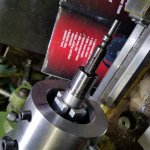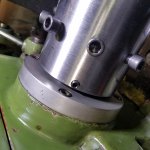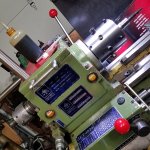I plan to make a front spider sometime soon and have been mulling over a couple of options but would like to know your thoughts guys on what your currently using or if you were to make a new one how you would spec it to possibley improve on the one you currently have?
Things Im thinking about are;
The number and size of the contact points - would 6 be better than 4 or would 8 be king - with 8 I could adjust with 4 and then snug things a little tighter later?
The profile of the contact points - are flats ok depending on screw contact point diameter or should the points be domed?
The pitch of the screws - how fine do we really need to go to make adjustment nice and progressive without jumping past?
Screw diameter?
Any other thoughts on the ultimate front spider design?
Now Ive been working just fine in a 4 jaw with round contact pads added but I had a 20" barrel this week that made things a little more tricky in that I had to fit an extension to the muzzle end so I could still reach my back spider. If I dropped the 4 jaw I would gain another 4 inches hence making a front spider will be wise.
With the collective knowledge we have here could we design the ultimate front spider I wonder?
Things Im thinking about are;
The number and size of the contact points - would 6 be better than 4 or would 8 be king - with 8 I could adjust with 4 and then snug things a little tighter later?
The profile of the contact points - are flats ok depending on screw contact point diameter or should the points be domed?
The pitch of the screws - how fine do we really need to go to make adjustment nice and progressive without jumping past?
Screw diameter?
Any other thoughts on the ultimate front spider design?
Now Ive been working just fine in a 4 jaw with round contact pads added but I had a 20" barrel this week that made things a little more tricky in that I had to fit an extension to the muzzle end so I could still reach my back spider. If I dropped the 4 jaw I would gain another 4 inches hence making a front spider will be wise.
With the collective knowledge we have here could we design the ultimate front spider I wonder?
Last edited:




